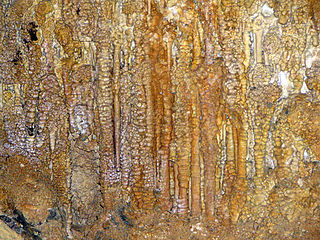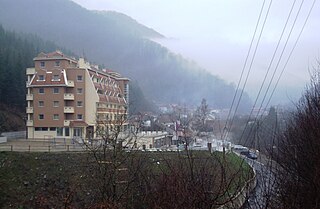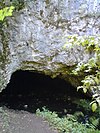
The Balkan mountain range is a mountain range in the eastern part of the Balkan Peninsula in Southeastern Europe. The range is conventionally taken to begin at the peak of Vrashka Chuka on the border between Bulgaria and Serbia. It then runs for about 560 kilometres (350 mi), first in a south-easterly direction along the border, then eastward across Bulgaria, forming a natural barrier between the northern and southern halves of the country, before finally reaching the Black Sea at Cape Emine. The mountains reach their highest point with Botev Peak at 2,376 metres (7,795 ft).

Resava Cave or Resavska Cave is a cave near Jelovac in eastern Serbia, about 20 kilometres from Despotovac. It is one of the largest cave systems in Serbia, with the corridors about 4.5 kilometres long.

The Stopića Cave is a limestone cave near Sirogojno, on the slopes of Mount Zlatibor in western Serbia. It has been protected by the state as a natural monument. By 2022 it became the most visited cave in Serbia.
Petnica is a small village near Valjevo, Serbia. According to the census of 2002, there were 614 inhabitants.

The Dajbabe Monastery is an Orthodox Christian Monastery in Podgorica, Montenegro. It is located in a cave on Dajbabe hill, which raises above Zeta valley. The Dajbabe Monastery was dedicated to Uspenje Bogorodice or the Assumption of Mary, the monastery was founded in 1897. In the beginning, only the space of the cave was used as a sanctuary, with the plan to be expanded later with chapels. The visible part of the church is situated outside the cave, depicting a spacious entrance porch with two belfries. The Dajbabe Monastery also possesses a reliquary with the relics of St. Simeon Dajbabe.

Valjevo is a city and the administrative center of the Kolubara District in western Serbia. According to the 2022 census, the administrative area of Valjevo had 82,169 inhabitants, 56,145 of whom were urban dwellers.

Risovača Cave, is situated at the very entrance of the town of Aranđelovac in central Serbia around 17 m (56 ft) above the Kubršnica river valley. It is one of the most important archaeological sites of the Paleolithic in Serbia besides the Gradac Cave near Kragujevac. Its discovery confirmed the assumed existence of the Paleolithic culture south of the Sava-Danube line and provided new information on the life of prehistoric humans in Europe.

The Gradac is a river in western Serbia, a tributary of the Kolubara. It cuts a canyon in south–north direction with a length of 22.7 km. Its measured water course has a length of about 28 km and a total drop of 187 m. The source of the river Gradac is situated at the foot of the Povlen mountain.

The Smoke Cave or Kađenica is a cave-church located in the village of Dljin near Čačak on the right bank of the Zapadna Morava, one kilometre upstream from Ovčar Banja, Serbia.

The Church of Holy Apostles Peter and Paul, known as the Cave Church, is a Serbian Orthodox cave-church located on eastern slope of Mount Kopaonik near Lukovo, southern Serbia. it was built by the Serbian King Milutin in the 14th century and is dedicated to Saints Peter and Paul. It is part of the Monastery of St. Archangel Gabriel.

Gradac is a village in the municipality of Batočina, Serbia. According to the 2011 census, the village has a population of 206 people. The Gradac Cave located in the village is part of the Cultural Heritage of Serbia list, inscribed in 1979.

Lukovo is a village on the eastern slopes of Mount Kopaonik, in the municipality of Kuršumlija, in southern Serbia. It is a spa town of highest altitude in Serbia. According to the 2011 census, the village has a population of 275 inhabitants.

Ovčar Banja is a village and a spa located in the city of Čačak, Serbia. Located near the Ovčar-Kablar Gorge in the valley of the West Morava, it is known as the "Serbian Mount Athos" because of the numerous monasteries situated in this area. As of 2011 census, it has a population of 122 inhabitants.
Brežđe is a village in the Mionica municipality, Kolubara District in Serbia.
Cerje is a village situated in Niš municipality in Serbia.

The Zavala Monastery is a Serbian Orthodox monastery located in the village of Zavala on the southwestern edge of Popovo Polje, in Ravno, Bosnia and Herzegovina municipality, in the southernmost part of Bosnia and Herzegovina. It is first mentioned in 1514, which means that the monastery already existed by the early sixteenth century. The monastery was designated National Monument of Bosnia and Herzegovina by the KONS in 2003.

The Hadži-Prodan's Cave is an archaeological site of the Paleolithic period and a national natural monument, located in the village Raščići around 7 km (4.3 mi) from Ivanjica in western central Serbia. The rather narrow and high entrance with at an altitude of 630 m (2,070 ft) above sea level sits about 40 m (130 ft) above the Rašćanska river valley bed and is oriented towards the south. The 345 m (1,132 ft) long cave was formed during the Late Cretaceous in "thick-bedded to massive" Senonian limestone. Prehistoric pottery shards and Pleistocene faunal fossils had already been collected by Zoran Vučićević from Ivanjica. Animal fossils especially Cave bear and Iron Age artifact discoveries during an unrelated areal survey were reportedly made at the cave entrance and in the main cavern. The site is named in honor of Hadži-Prodan, a 19th century Serbian revolutionary.

Pešturina is a cave in the municipality of Niška Banja in southeast Serbia. It is located southwest of Jelašnica and 20 km (12 mi) southeast of Niš. Artifacts from the Middle and Upper Paleolithic periods were discovered since the archaeological excavations began in 2006. The remains, identified as the Mousterian culture, were dated from 111,000 BP+ 5,000 to 39,000 BP + 3,000, which makes Pešturina one of the latest surviving Neanderthal habitats. The cave has been nicknamed the "Serbian Atapuerca".





















